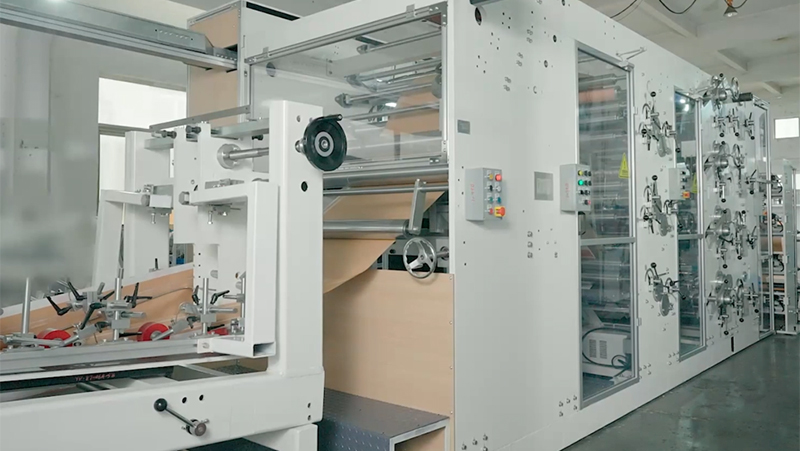Innovations in Laminated Paper Bag Manufacturing: A Comprehensive Guide to Modern Machinery
Release time:2025-05-26 Classification:Knowledge
The global shift toward sustainable packaging has propelled laminated paper bags into the spotlight as a versatile, eco-friendly alternative to traditional plastic. At the heart of this transformation lies advanced manufacturing technology, with laminated paper bag machines playing a pivotal role in meeting demand for durable, customizable, and recyclable solutions. This article explores the engineering, functionality, and applications of these specialized machines, offering insights into their critical role in modern packaging industries.

1. What is a Laminated Paper Bag Machine?
A laminated paper bag machine is a precision-engineered system designed to automate the production of multi-layered paper bags. By combining layers of kraft paper with laminated materials—such as biodegradable films or water-resistant coatings—these machines create robust, functional packaging suitable for industries ranging from retail to food service. Unlike standard paper bag equipment, laminated models integrate specialized components for handling composite materials while maintaining high-speed output and structural consistency.
Key processes include:
- Material feeding and alignment: Precise unwinding systems for paper rolls and laminated films.
- Adhesive application: Controlled glue dispensing to bond layers without compromising flexibility.
- Printing and customization: Optional flexographic or digital printing units for branding.
- Forming and sealing: Heat or ultrasonic sealing mechanisms for leak-proof edges.
- Cutting and finishing: Automated die-cutting and handle attachment systems.
2. Core Components and Workflow
Modern laminated paper bag machines incorporate modular designs to optimize efficiency and adaptability. Below are essential subsystems:
- Unwind and Tension Control
Dual unwinders manage paper and laminate rolls simultaneously, ensuring tension stability to prevent wrinkles or misalignment. Advanced sensors adjust tension in real time, critical for maintaining layer uniformity. - Lamination Unit
This stage bonds the paper substrate with laminated films using eco-friendly adhesives or thermal processes. The unit’s temperature and pressure settings are calibrated to achieve optimal adhesion without degrading material integrity. - Printing Module
High-resolution printing units apply designs directly onto the laminated surface. UV-curable inks are often used for smudge-resistant, vibrant graphics that withstand handling. - Bag Forming Section
The laminated material is folded into a tubular shape, with side gussets added for structural support. Precision servo motors control folding angles, ensuring consistent dimensions. - Bottom Sealing and Cutting
Heat-sealing jaws or ultrasonic systems create airtight seams, while rotary blades trim bags to specified lengths. For handled bags, an integrated handle attachment system applies paper or twisted rope handles seamlessly.
3. Advantages of Advanced Laminated Paper Bag Machines
Investing in state-of-the-art machinery offers manufacturers several strategic benefits:
- Sustainability Compliance
Machines engineered for biodegradable laminates align with global regulations on single-use plastics. By supporting recyclable and compostable materials, they help brands meet ESG goals. - High-Speed Production
Automated systems can produce 80–150 bags per minute, depending on complexity, significantly outpacing manual methods. Quick-changeover designs further reduce downtime between orders. - Customization Flexibility
Adjustable parameters allow for variable bag sizes, handle types, and print designs. This adaptability caters to niche markets, such as luxury retail or organic food packaging. - Durability Assurance
Multi-layer lamination enhances tear resistance and load-bearing capacity, making bags suitable for heavy-duty applications like pet food or industrial products.
4. Industry Applications
Laminated paper bags manufactured by these machines serve diverse sectors:
- Food and Beverage
Grease-resistant laminates protect baked goods, snacks, and frozen foods. Breathable films extend the shelf life of fresh produce. - Retail and Fashion
High-gloss finishes and embossed handles create premium unboxing experiences. Reinforced bottoms support heavier items like electronics or cosmetics. - Agriculture
Waterproof laminated bags safely store seeds, fertilizers, and animal feed in humid environments. - Healthcare
Sterile, puncture-resistant packaging is used for medical supplies and pharmaceuticals.
5. Maintenance and Optimization
To maximize machine longevity and output quality, operators must prioritize:
- Regular calibration of tension controls and sealing temperatures.
- Routine cleaning of adhesive nozzles and cutting blades to prevent residue buildup.
- Software updates for PLC (Programmable Logic Controller) systems to enhance automation accuracy.
- Material compatibility testing when switching laminate types to avoid jams or seal failures.
6. Future Trends in Laminated Bag Machinery
Emerging technologies are reshaping the industry:
- AI-Driven Quality Control: Machine vision systems detect defects in real time, reducing waste.
- Energy-Efficient Designs: Solar-powered components and low-heat sealing methods cut carbon footprints.
- Smart Packaging Integration: Machines equipped with RFID or QR code applicators enable traceability and interactive consumer engagement.
Laminated paper bag machines represent a convergence of sustainability and innovation, empowering manufacturers to meet evolving market demands. By leveraging automation, customization, and eco-conscious materials, these systems not only streamline production but also contribute to a circular economy. As technology advances, the role of laminated paper bags in replacing plastic will continue to expand, driven by machinery that prioritizes efficiency, durability, and environmental stewardship.






